MyBatis-Plus
MyBatis-Plus介绍
MyBatis-Plus(简称MP)是一个MyBatis的增强工具,在MyBatis的基础上只做增强不做改变,为简化开发、提高效率而生
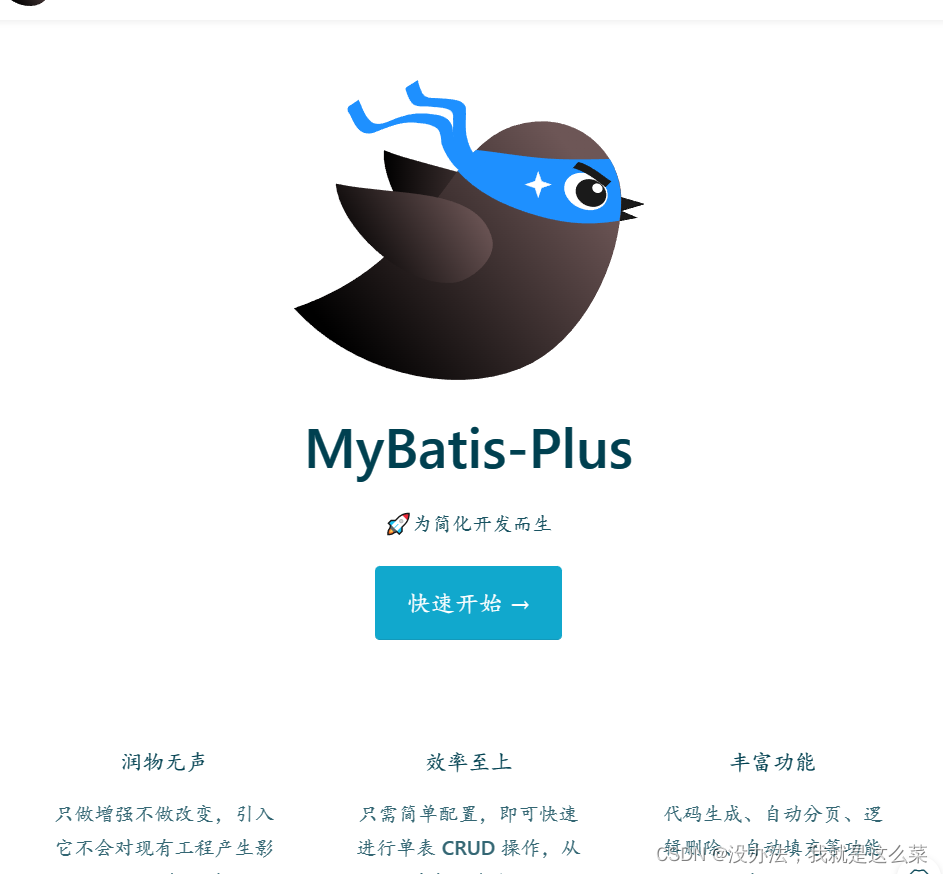
特性
- 无侵入:只做增强不做改变,引入它不会对现有工程产生影响
- 损耗小:启动既会自动注入基本CRUD,性能基本无损耗,直接面向对象操作
- 强大的CRUD操作:内置通用Mapper、通用Service、仅仅通过少量配置即可实现单表大部分CRUD操作,更有强大的条件构造器,满足各类使用需求
- 支持Lambda形式调用:通过Lambda表达式,方便的编写各类查询条件,无需再担心字段写错
- 支持多种数据库:支持MySQL、MariaDB、Oracle、DB2、H2、HSQL、SQLite、Postgre
- 支持主键自动生成:支持多达4种主键策略(内含分布式唯一ID生成器-Sequence),可自由配置,完美解决主键问题
- 支持XML热加载:Mapper对应的xml支持热加载,对于简单的CRUD操作,甚至可以无XML启动
- 支持自定义全局通用操作:支持全局通用方法注入
- 支持关键词自动转义:支持数据库关键词自动转义,还可自定义关键词
- 内置代码生成器:采用代码或者Maven插件可快速生成Mapper、Model、Service、Controller层代码,支持模板引擎,更有超多自定义配置
- 内置分页插件:基于MyBatis物理分页,开发者无需关心具体操作,配置好插件之后,写分页等同于普通List查询
- 内置性能分析插件:可输出Sql语句以及其执行时间,建议开发测试时启用该功能,能快速揪出慢查询
- 内置全局拦截插件:提供全表delete、update操作智能分析阻断,也可自定义拦截规则,预防误操作
- 内置sql注入剥离器:支持Sql注入剥离,有效预防Sql注入攻击
架构
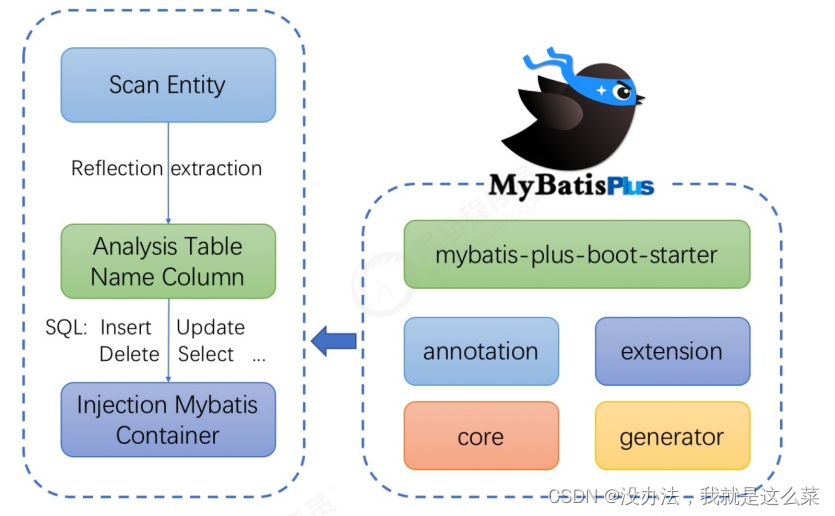
快速开始
创建数据库以及表
-- 创建测试表
CREATE TABLE `tb_user` (
`id` bigint(20) NOT NULL AUTO_INCREMENT COMMENT '主键ID',
`user_name` varchar(20) NOT NULL COMMENT '用户名',
`password` varchar(20) NOT NULL COMMENT '密码',
`name` varchar(30) DEFAULT NULL COMMENT '姓名',
`age` int(11) DEFAULT NULL COMMENT '年龄',
`email` varchar(50) DEFAULT NULL COMMENT '邮箱',
PRIMARY KEY (`id`)
) ENGINE=InnoDB AUTO_INCREMENT=1 DEFAULT CHARSET=utf8;
-- 插入测试数据
INSERT INTO `tb_user` (`id`, `user_name`, `password`, `name`, `age`, `email`) VALUES
('1', 'zhangsan', '123456', '张三', '18', 'test1@itcast.cn');
INSERT INTO `tb_user` (`id`, `user_name`, `password`, `name`, `age`, `email`) VALUES
('2', 'lisi', '123456', '李四', '20', 'test2@itcast.cn');
INSERT INTO `tb_user` (`id`, `user_name`, `password`, `name`, `age`, `email`) VALUES
('3', 'wangwu', '123456', '王五', '28', 'test3@itcast.cn');
INSERT INTO `tb_user` (`id`, `user_name`, `password`, `name`, `age`, `email`) VALUES
('4', 'zhaoliu', '123456', '赵六', '21', 'test4@itcast.cn');
INSERT INTO `tb_user` (`id`, `user_name`, `password`, `name`, `age`, `email`) VALUES
('5', 'sunqi', '123456', '孙七', '24', 'test5@itcast.cn');
创建工程
导入依赖
<dependency>
<groupId>junit</groupId>
<artifactId>junit</artifactId>
<version>4.11</version>
<scope>test</scope>
</dependency>
<!-- mybatis-plus插件依赖 -->
<dependency>
<groupId>com.baomidou</groupId>
<artifactId>mybatis-plus</artifactId>
<version>3.1.1</version>
</dependency>
<!-- MySql -->
<dependency>
<groupId>mysql</groupId>
<artifactId>mysql-connector-java</artifactId>
<version>5.1.47</version>
</dependency>
<!-- 连接池 -->
<dependency>
<groupId>com.alibaba</groupId>
<artifactId>druid</artifactId>
<version>1.0.11</version>
</dependency>
<!--简化bean代码的工具包-->
<dependency>
<groupId>org.projectlombok</groupId>
<artifactId>lombok</artifactId>
<optional>true</optional>
<version>1.18.4</version>
</dependency>
<dependency>
<groupId>org.slf4j</groupId>
<artifactId>slf4j-log4j12</artifactId>
<version>1.6.4</version>
</dependency>
log4j.properties
log4j.rootLogger=DEBUG,A1
log4j.appender.A1=org.apache.log4j.ConsoleAppender
log4j.appender.A1.layout=org.apache.log4j.PatternLayout
log4j.appender.A1.layout.ConversionPattern=[%t] [%c]-[%p] %m%n
MyBatis实现查询User
1、编写mybatis-config.xml文件
<?xml version="1.0" encoding="UTF-8" ?>
<!DOCTYPE configuration PUBLIC "-//mybatis.org//DTD Config 3.0//EN" "http://mybatis.org/dtd/mybatis-3-config.dtd">
<configuration>
<!--读取jdbc.properties-->
<properties resource="jdbc.properties"/>
<!--定义别名-->
<typeAliases>
<package name="com.dc.domain"/>
</typeAliases>
<!--数据库环境-->
<environments default="development">
<environment id="development">
<transactionManager type="JDBC"/>
<dataSource type="POOLED">
<property name="driver" value="${driver}"/>
<property name="url" value="${url}"/>
<property name="username" value="${username}"/>
<property name="password" value="${password}"/>
</dataSource>
</environment>
</environments>
<!--加载mapper-->
<mappers>
<package name="com.dc.mapper"/>
</mappers>
</configuration>
2、编写jdbc.properties文件
driver=com.mysql.jdbc.Driver
url=jdbc:mysql://localhost:3306/test?useUnicode=true&characterEncoding=utf8&autoReconnect=true&allowMultiQueries=true&useSSL=false"
username=root
password=root
3、编写User实体类对象
@Data
@AllArgsConstructor
@NoArgsConstructor
public class User {
private Long id;
private String username;
private String password;
private String name;
private Integer age;
private String email;
@Override
public String toString() {
return "User{" +
"id=" + id +
", username='" + username + '\'' +
", password='" + password + '\'' +
", name='" + name + '\'' +
", age=" + age +
", email='" + email + '\'' +
'}';
}
}
4、编写UserMapper接口
public interface UserMapper {
List<User> findAll();
}
5、编写UserMapper.xml文件
<?xml version="1.0" encoding="UTF-8" ?>
<!DOCTYPE mapper PUBLIC "-//mybatis.org//DTD Mapper 3.0//EN" "http://mybatis.org/dtd/mybatis-3-mapper.dtd">
<mapper namespace="com.dc.mapper.UserMapper">
<select id="findAll" resultType="user">
select * from tb_user
</select>
</mapper>
6、测试
public class Tes {
private UserMapper userMapper;
@Before
public void test() throws IOException {
InputStream resource = Resources.getResourceAsStream("mybatis-config.xml");
SqlSessionFactory sqlSessionFactory = new SqlSessionFactoryBuilder().build(resource);
SqlSession sqlSession = sqlSessionFactory.openSession(true);
userMapper = sqlSession.getMapper(UserMapper.class);
}
@Test
public void testUserList(){
List<User> userList = userMapper.findAll();
for (User user : userList) {
System.out.println(user);
}
}
}
结果:
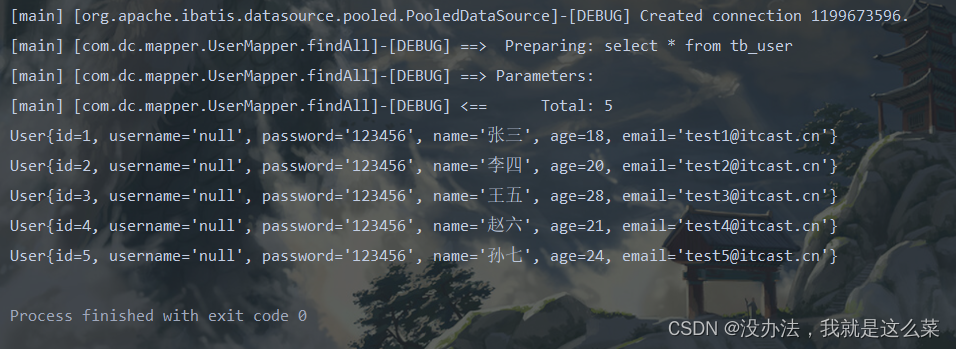
MyBatis+MP实现查询User
1、将UserMapper继承BaseMapper,将拥有BaseMapper的所有方法:
public interface UserMapper extends BaseMapper<User> {
List<User> findAll();
}
2、使用MP中的MybatisSqlSessionFactoryBuilder进程构建:
@Test
public void testUserList1() throws IOException {
InputStream resource = Resources.getResourceAsStream("mybatis-config.xml");
SqlSessionFactory sqlSessionFactory = new MybatisSqlSessionFactoryBuilder().build(resource);
SqlSession sqlSession = sqlSessionFactory.openSession(true);
userMapper = sqlSession.getMapper(UserMapper.class);
// 可以调用BaseMapper中定义的方法
List<User> userList = userMapper.selectList(null);
for (User user : userList) {
System.out.println(user);
}
}
这是会报错:

解决方案:在User对象中添加@TableName,指定数据库表名
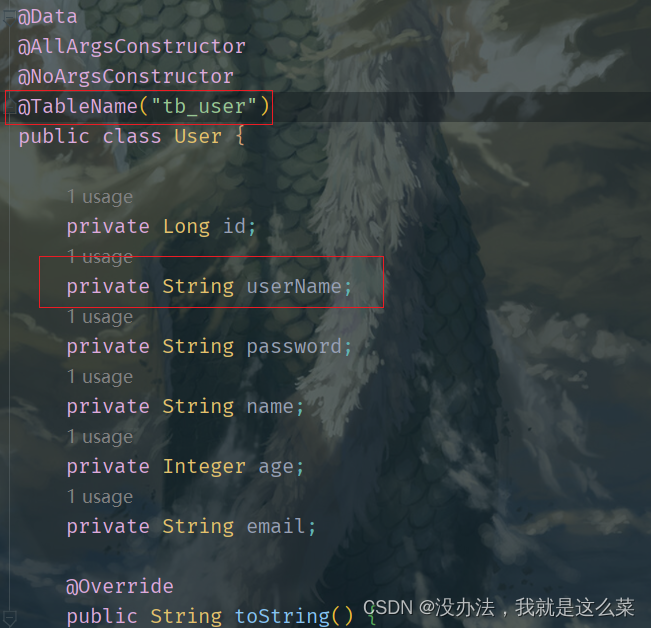
测试结果:

简单说明:
- 由于使用了MybatisSqlSessionFactoryBuilder进行了构建,继承的BaseMapper中的方法就载入到了SqlSession中,所以就可以直接使用相关的方法:
Spring+Mybatis+MP
导入依赖
<!--spring-->
<dependency>
<groupId>org.springframework</groupId>
<artifactId>spring-webmvc</artifactId>
<version>5.1.6.RELEASE</version>
</dependency>
<dependency>
<groupId>org.springframework</groupId>
<artifactId>spring-jdbc</artifactId>
<version>5.1.6.RELEASE</version>
</dependency>
<dependency>
<groupId>org.springframework</groupId>
<artifactId>spring-test</artifactId>
<version>5.1.6.RELEASE</version>
</dependency>
实现查询user
1、编写jdbc.properties
jdbc.driver=com.mysql.jdbc.Driver
jdbc.url=jdbc:mysql://localhost:3306/test?useUnicode=true&characterEncoding=utf-8&useSSL=false&serverTimezone=Asia/Shanghai
jdbc.username=root
jdbc.password=root
2、编写applicationContext.xml
<?xml version="1.0" encoding="UTF-8"?>
<beans xmlns="http://www.springframework.org/schema/beans"
xmlns:xsi="http://www.w3.org/2001/XMLSchema-instance"
xmlns:context="http://www.springframework.org/schema/context"
xsi:schemaLocation="http://www.springframework.org/schema/beans
http://www.springframework.org/schema/beans/spring-beans.xsd
http://www.springframework.org/schema/context
http://www.springframework.org/schema/context/spring-context.xsd">
<!--配置所有properties文件-->
<context:property-placeholder location="classpath:jdbc.properties"></context:property-placeholder>
<!--定义数据源-->
<bean id="dataSource" class="com.alibaba.druid.pool.DruidDataSource">
<property name="driverClassName" value="${jdbc.driver}"/>
<property name="url" value="${jdbc.url}"/>
<property name="username" value="${jdbc.username}"/>
<property name="password" value="${jdbc.password}"/>
<property name="maxActive" value="10"/>
<property name="minIdle" value="5"/>
</bean>
<!--MP提供的SqlSessionFactory,完成了Spring与MP的整合-->
<bean id="sqlSessionFactory" class="com.baomidou.mybatisplus.extension.spring.MybatisSqlSessionFactoryBean">
<property name="dataSource" ref="dataSource"/>
<property name="configLocation" value="classpath:mybatis-config.xml"/>
</bean>
<bean class="org.mybatis.spring.mapper.MapperScannerConfigurer">
<property name="basePackage" value="com.dc.mapper"/>
</bean>
<beans default-autowire="byType"/>
</beans>
3、编写user对象以及UserMapper接口:
@Data
@AllArgsConstructor
@NoArgsConstructor
@TableName("tb_user")
public class User {
private Long id;
private String userName;
private String password;
private String name;
private Integer age;
private String email;
@Override
public String toString() {
return "User{" +
"id=" + id +
", username='" + userName + '\'' +
", password='" + password + '\'' +
", name='" + name + '\'' +
", age=" + age +
", email='" + email + '\'' +
'}';
}
}
public interface UserMapper extends BaseMapper<User> {
}
4、测试
@RunWith(SpringJUnit4ClassRunner.class)
@ContextConfiguration(locations = "classpath:applicationContext.xml")
public class TestMybatis {
@Autowired
private UserMapper userMapper;
@Test
public void test() {
List<User> users = userMapper.selectList(null);
for (User user : users) {
System.out.println(user);
}
}
}
结果:

SpringBoot+Mybatis+MP
导入依赖
<?xml version="1.0" encoding="UTF-8"?>
<project xmlns="http://maven.apache.org/POM/4.0.0" xmlns:xsi="http://www.w3.org/2001/XMLSchema-instance"
xsi:schemaLocation="http://maven.apache.org/POM/4.0.0 https://maven.apache.org/xsd/maven-4.0.0.xsd">
<modelVersion>4.0.0</modelVersion>
<parent>
<groupId>org.springframework.boot</groupId>
<artifactId>spring-boot-starter-parent</artifactId>
<version>2.7.5</version>
<relativePath/> <!-- lookup parent from repository -->
</parent>
<groupId>com.dc</groupId>
<artifactId>smp</artifactId>
<version>0.0.1-SNAPSHOT</version>
<name>smp</name>
<description>smp</description>
<properties>
<java.version>17</java.version>
</properties>
<dependencies>
<dependency>
<groupId>org.springframework.boot</groupId>
<artifactId>spring-boot-starter</artifactId>
</dependency>
<dependency>
<groupId>com.mysql</groupId>
<artifactId>mysql-connector-j</artifactId>
<scope>runtime</scope>
</dependency>
<dependency>
<groupId>org.projectlombok</groupId>
<artifactId>lombok</artifactId>
<optional>true</optional>
</dependency>
<dependency>
<groupId>org.springframework.boot</groupId>
<artifactId>spring-boot-starter-test</artifactId>
<scope>test</scope>
</dependency>
<!--mybatis-plus的springboot支持-->
<dependency>
<groupId>com.baomidou</groupId>
<artifactId>mybatis-plus-boot-starter</artifactId>
<version>3.1.1</version>
</dependency>
<dependency>
<groupId>org.slf4j</groupId>
<artifactId>slf4j-log4j12</artifactId>
</dependency>
</dependencies>
<build>
<plugins>
<plugin>
<groupId>org.springframework.boot</groupId>
<artifactId>spring-boot-maven-plugin</artifactId>
<configuration>
<excludes>
<exclude>
<groupId>org.projectlombok</groupId>
<artifactId>lombok</artifactId>
</exclude>
</excludes>
</configuration>
</plugin>
</plugins>
</build>
</project>
log4j.properties
log4j.rootLogger=DEBUG,A1
log4j.appender.A1=org.apache.log4j.ConsoleAppender
log4j.appender.A1.layout=org.apache.log4j.PatternLayout
log4j.appender.A1.layout.ConversionPattern=[%t] [%c]-[%p] %m%n
编写application.properties
spring.application.name=smp
spring.datasource.driver-class-name=com.mysql.jdbc.Driver
spring.datasource.url=jdbc:mysql://localhost:3306/test?useUnicode=true&characterEncoding=utf8&autoReconnect=true&allowMultiQueries=true&useSSL=false
spring.datasource.username=root
spring.datasource.password=root
编写pojo
@Data
@AllArgsConstructor
@NoArgsConstructor
@TableName("tb_user")
public class User {
private Long id;
private String userName;
private String password;
private String name;
private Integer age;
private String email;
@Override
public String toString() {
return "User{" +
"id=" + id +
", username='" + userName + '\'' +
", password='" + password + '\'' +
", name='" + name + '\'' +
", age=" + age +
", email='" + email + '\'' +
'}';
}
}
编写mapper
@Mapper
public interface UserMapper extends BaseMapper<User> {
}
编写启动类
@MapperScan("com.dc.mapper")
@SpringBootApplication
public class SmpApplication {
public static void main(String[] args) {
SpringApplication.run(SmpApplication.class, args);
}
}
测试用例
@RunWith(SpringRunner.class)
@SpringBootTest
public class UserMapperTest {
@Autowired
private UserMapper userMapper;
@Test
public void test() {
List<User> users = userMapper.selectList(null);
for (User user : users) {
System.out.println(user);
}
}
}
结果:
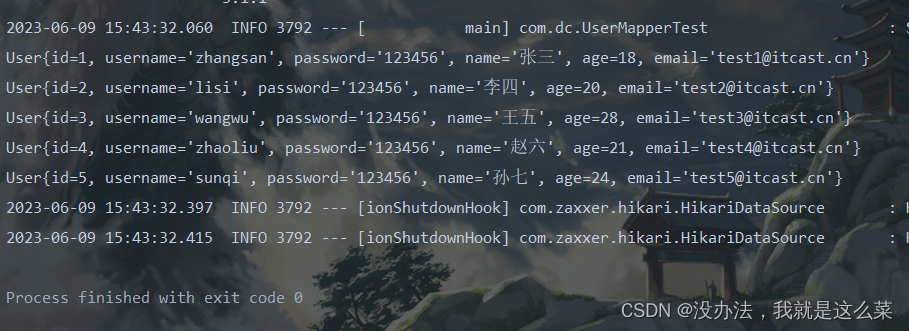
通用CRUD
插入操作
方法定义
/**
* 插入一条记录
*
* @param entity 实体对象
*/
int insert(T entity);
测试用例
@Test
public void testInsert() {
User user = new User();
user.setAge(20);
user.setEmail("test@dc.com");
user.setUserName("caocao");
user.setName("曹操");
user.setPassword("123456");
int insert = userMapper.insert(user);
System.out.println("result = " + insert);
System.out.println(user.getId());
}
结果:

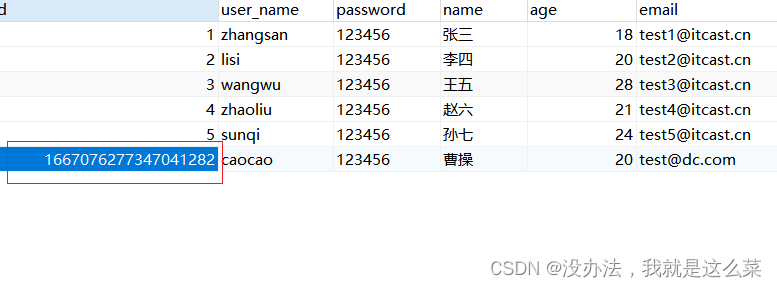
可以看到,数据库已经写入到了数据库,但是,id的值不正确,目标是数据库自增长,实际是MP生成了id的值写入到了数据库
如何设置id的生成策略?
MP支持的id策略:
package com.baomidou.mybatisplus.annotation;
import lombok.Getter;
/**
* 生成ID类型枚举类
*/
@Getter
public enum IdType {
/**
* 数据库ID自增
*/
AUTO(0),
/**
* 该类型为未设置主键类型
*/
NONE(1),
/**
* 用户输入ID
* <p>该类型可以通过自己注册自动填充插件进行填充</p>
*/
INPUT(2),
/* 以下3种类型、只有当插入对象ID 为空,才自动填充。 */
/**
* 全局唯一ID (idWorker)
*/
ID_WORKER(3),
/**
* 全局唯一ID (UUID)
*/
UUID(4),
/**
* 字符串全局唯一ID (idWorker 的字符串表示)
*/
ID_WORKER_STR(5);
private final int key;
IdType(int key) {
this.key = key;
}
}
修改User对象
@Data
@AllArgsConstructor
@NoArgsConstructor
@TableName("tb_user")
public class User {
// 指定id类型为自增
@TableId(type = IdType.AUTO)
private Long id;
private String userName;
private String password;
private String name;
private Integer age;
private String email;
@Override
public String toString() {
return "User{" +
"id=" + id +
", username='" + userName + '\'' +
", password='" + password + '\'' +
", name='" + name + '\'' +
", age=" + age +
", email='" + email + '\'' +
'}';
}
}
结果:

@TableField
在MP中通过@TableField注解可以指定字段的一些属性,常常解决的问题有2个:
- 对象中的属性名和字段名不一致
- 对象中的属性字段在表中不存在的问题
使用:
@Data
@AllArgsConstructor
@NoArgsConstructor
@TableName("tb_user")
public class User {
// 指定id类型为自增
@TableId(type = IdType.AUTO)
private Long id;
private String userName;
private String password;
private String name;
private Integer age;
// 解决字段名不一致
@TableId(value = "email")
private String email;
// 该字段在数据库中不存在
@TableField(exist = false)
private String address;
@Override
public String toString() {
return "User{" +
"id=" + id +
", username='" + userName + '\'' +
", password='" + password + '\'' +
", name='" + name + '\'' +
", age=" + age +
", email='" + email + '\'' +
'}';
}
}
其他用法,如某字段不加入查询字段:
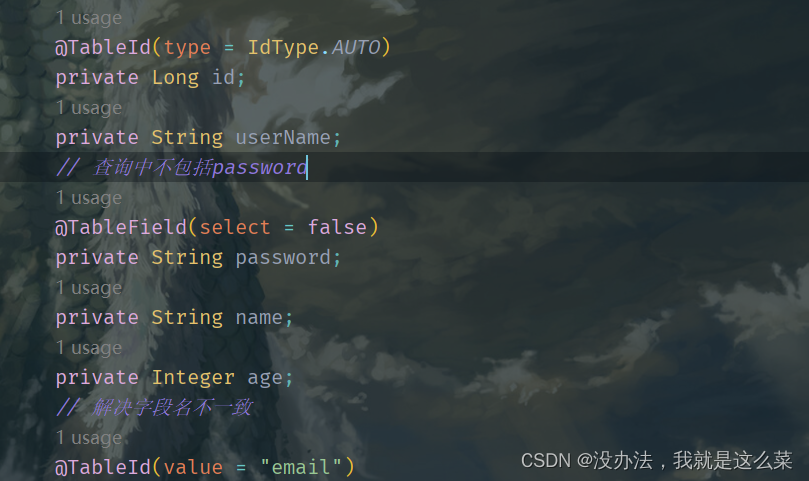
效果:
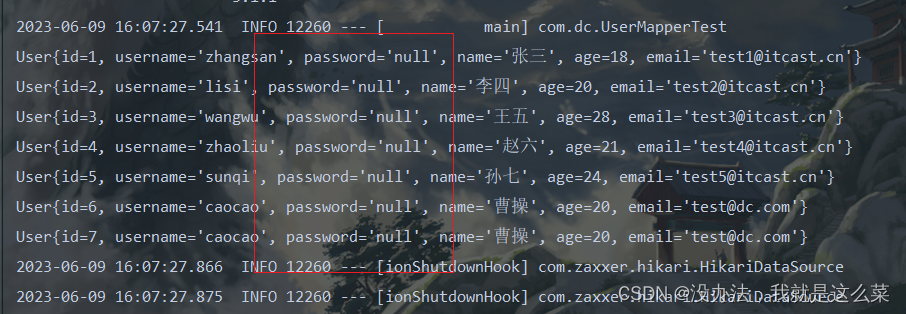
更新操作
在MP中,更新操作有2种,一种是根据id更新,另一种是根据条件更新
根据id更新
方法定义:
/**
* 根据 ID 修改
*
* @param entity 实体对象
*/
int updateById(@Param(Constants.ENTITY) T entity);
测试
@Test
public void testUpdate() {
User user = new User();
// 主键
user.setId(1L);
// 更新字段
user.setAge(21);
// 根据id更新,更新不为null的字段
userMapper.updateById(user);
}
效果:

根据条件更新
方法定义:
/**
* 根据 whereEntity 条件,更新记录
*
* @param entity 实体对象 (set 条件值,可以为 null)
* @param updateWrapper 实体对象封装操作类(可以为 null,里面的 entity 用于生成 where 语句)
*/
int update(@Param(Constants.ENTITY) T entity, @Param(Constants.WRAPPER) Wrapper<T>
updateWrapper);
测试用例:
@Test
public void testUpdate2() {
User user = new User();
// 更新字段
user.setAge(22);
// 更新条件
QueryWrapper<User> wrapper = new QueryWrapper<>();
// id为6的字段
wrapper.eq("id", 6);
// 执行更新操作
int update = userMapper.update(user, wrapper);
System.out.println("update =" + update);
}
或者,通过UpdateWrapper进行更新:
@Test
public void testUpdate3() {
// 更新条件
UpdateWrapper<User> wrapper = new UpdateWrapper<>();
wrapper.eq("id", 6).set("age", 23);
// 执行更新操作
int update = userMapper.update(null, wrapper);
System.out.println("update =" + update);
}
测试结果:

删除操作
deleteById
方法定义:
/**
* 根据 ID 删除
*
* @param id 主键ID
*/
int deleteById(Serializable id);
测试用例:
@Test
public void testDelete() {
// 执行删除操作
int i = userMapper.deleteById(6L);
System.out.println("i = " + i);
}
结果:

id为6的数据被删除
deleteByMap
方法定义:
/**
* 根据 columnMap 条件,删除记录
*
* @param columnMap 表字段 map 对象
*/
int deleteByMap(@Param(Constants.COLUMN_MAP) Map<String, Object> columnMap);
测试用例:
@Test
public void testDeleteByMap() {
HashMap<String, Object> columnMap = new HashMap<>();
columnMap.put("age", 21);
columnMap.put("name", "张三");
// 将column中的元素设置为删除的条件,多个之间为and关系
int i = userMapper.deleteByMap(columnMap);
System.out.println("i = " + i);
}
效果:

delete
方法定义
/**
* 根据 entity 条件,删除记录
*
* @param wrapper 实体对象封装操作类(可以为 null)
*/
int delete(@Param(Constants.WRAPPER) Wrapper<T> wrapper);
测试用例:
@Test
public void testDelete1() {
User user = new User();
user.setAge(20);
user.setName("张三");
// 将实体对象进行封装,包装为操作条件
QueryWrapper<User> wrapper = new QueryWrapper<>(user);
int delete = userMapper.delete(wrapper);
System.out.println("delete = "+ delete);
}
效果:

deleteBatchIds
方法定义:
/**
* 删除(根据ID 批量删除)
*
* @param idList 主键ID列表(不能为 null 以及 empty)
*/
int deleteBatchIds(@Param(Constants.COLLECTION) Collection<? extends Serializable>
idList);
测试用例:
@Test
public void testDeleteByMap1() {
// 根据id集合批量删除
int i = userMapper.deleteBatchIds(Arrays.asList(6L, 10L, 20L));
System.out.println("i = " + i);
}
效果:

查询操作
MP提供了多种查询操作,包括根据id查询、批量查询、查询单条数据、查询列表、分页查询等操作
selectById
方法定义
/**
* 根据 ID 查询
*
* @param id 主键ID
*/
T selectById(Serializable id);
测试用例
@Test
public void testSelectById() {
// 根据id查询数据
User user = userMapper.selectById(2L);
System.out.println("result = " + user);
}
效果:
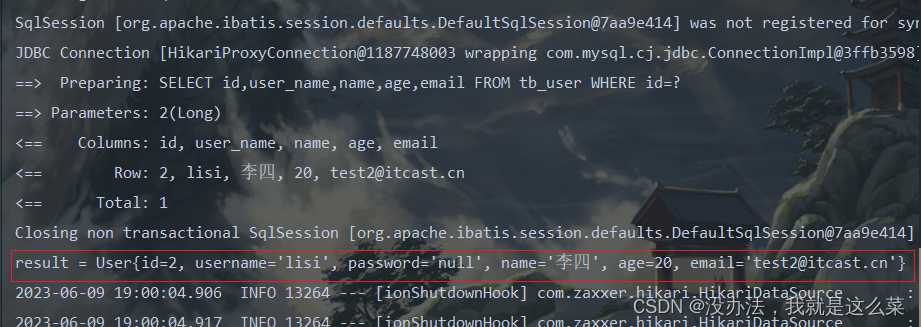
selectBatchIds
方法定义:
/**
* 查询(根据ID 批量查询)
*
* @param idList 主键ID列表(不能为 null 以及 empty)
*/
List<T> selectBatchIds(@Param(Constants.COLLECTION) Collection<? extends Serializable>
idList);
测试用例:
@Test
public void testSelectBatchIds() {
// 根据id批量查询数据
List<User> users = userMapper.selectBatchIds(Arrays.asList(2L, 3L, 10L));
for (User user : users) {
System.out.println(user);
}
}
效果:
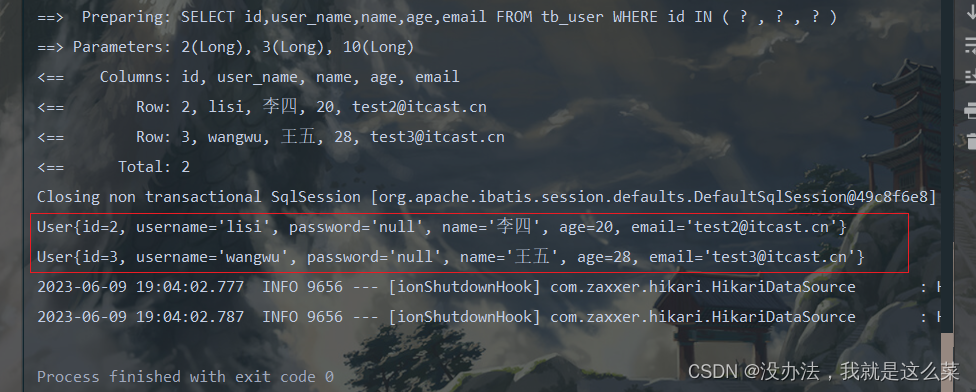
selectOne
方法定义:
/**
* 根据 entity 条件,查询一条记录
*
* @param queryWrapper 实体对象封装操作类(可以为 null)
*/
T selectOne(@Param(Constants.WRAPPER) Wrapper<T> queryWrapper);
测试用例:
@Test
public void testSelectOne() {
// 根据id批量查询数据
QueryWrapper<User> wrapper = new QueryWrapper<>();
wrapper.eq("name", "李四");
// 根据条件查询一条数据,如果结果超过一条会报错
User user = userMapper.selectOne(wrapper);
System.out.println(user);
}
效果:

selectCount
方法定义:
/**
* 根据 Wrapper 条件,查询总记录数
*
* @param queryWrapper 实体对象封装操作类(可以为 null)
*/
Integer selectCount(@Param(Constants.WRAPPER) Wrapper<T> queryWrapper);
测试用例:
@Test
public void testSelectCount() {
QueryWrapper<User> wrapper = new QueryWrapper<>();
wrapper.gt("age", 23);
// 根据条件查询数据条数
Integer integer = userMapper.selectCount(wrapper);
System.out.println("integer = " + integer);
}
效果:
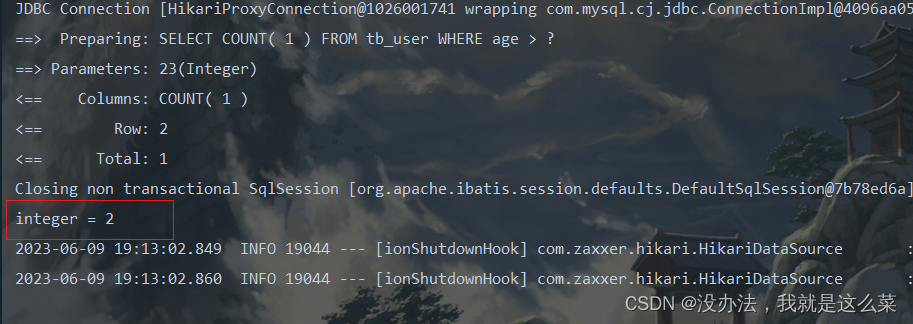
selectList
方法定义:
/**
* 根据 entity 条件,查询全部记录
*
* @param queryWrapper 实体对象封装操作类(可以为 null)
*/
List<T> selectList(@Param(Constants.WRAPPER) Wrapper<T> queryWrapper);
测试用例:
@Test
public void testSelectList() {
QueryWrapper<User> wrapper = new QueryWrapper<>();
wrapper.gt("age", 23);
// 根据条件查询数据
List<User> users = userMapper.selectList(wrapper);
for (User user : users) {
System.out.println(user);
}
}
效果:
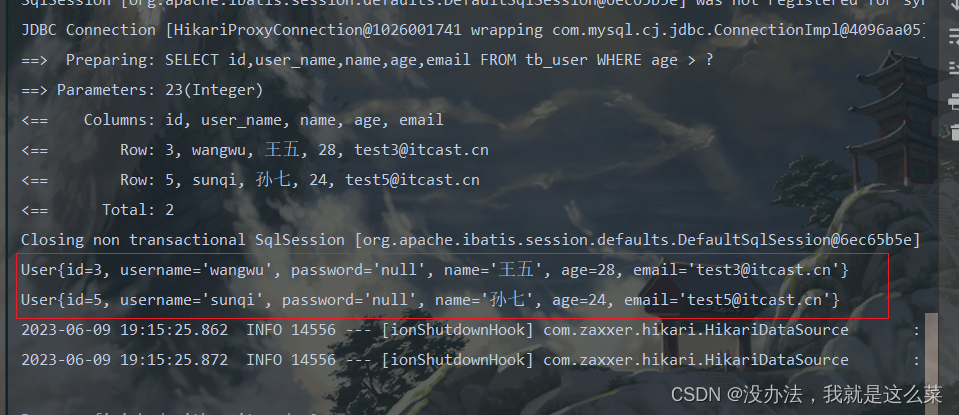
selectPage
方法定义:
/**
* 根据 entity 条件,查询全部记录(并翻页)
*
* @param page 分页查询条件(可以为 RowBounds.DEFAULT)
* @param queryWrapper 实体对象封装操作类(可以为 null)
*/
IPage<T> selectPage(IPage<T> page, @Param(Constants.WRAPPER) Wrapper<T> queryWrapper);
编写配置类:
@Configuration
@MapperScan("com.dc.mapper")
public class MybatisPlusConfig {
/**
* 分页插件
* @param
* @return
*/
@Bean
public PaginationInterceptor paginationInterceptor() {
return new PaginationInterceptor();
}
}
测试用例:
@Test
public void testSelectPage() {
QueryWrapper<User> wrapper = new QueryWrapper<>();
wrapper.gt("age", 18);
Page<User> page = new Page<>(1, 1);
// 根据条件查询数据
IPage<User> userIPage = userMapper.selectPage(page, wrapper);
System.out.println("数据总条数:" + userIPage.getTotal());
System.out.println("总页数:" + userIPage.getPages());
// 获取当前页面记录
List<User> records = userIPage.getRecords();
for (User record : records) {
System.out.println(record);
}
}
效果:

配置
在MP中有大量配置,其中有一部分是MyBatis原生的配置,另一部分是MP的配置。
基本配置
configLocation
MyBatis配置文件位置,如果有单独的MyBatis配置,请将其路径配置到configLocaotion中。
SpringBoot:
mybatis-plus.config-location = classpath:mybatis-config.xml
SpringMVC:
<bean id="sqlSessionFactory"
class="com.baomidou.mybatisplus.extension.spring.MybatisSqlSessionFactoryBean">
<property name="configLocation" value="classpath:mybatis-config.xml"/>
</bean>
mapperLocations
MyBatis Mapper所对应的xml文件位置,如果在Mapper中有自定义方法,(xml中有自定义实现),需要进行该配置,告诉Mapper所对应的xml文件位置
SpringBoot:
mybatis-plus.mapper-locations = classpath*:mybatis/*.xml
SpringMVC:
<bean id="sqlSessionFactory"
class="com.baomidou.mybatisplus.extension.spring.MybatisSqlSessionFactoryBean">
<property name="mapperLocations" value="classpath*:mybatis/*.xml"/>
</bean>
Maven多模块项目的扫描路径需以
classpath*:开头(即加载多个jar包下的xml文件)
typeAliasesPackage
MyBatis别名包扫描路径,通过该属性可以给包中的类注册别名,注册后再mapper对应的xml文件中可以直接使用类名,而不用使用全限定的类名(即xml中调用的时候不用包含类名)
SpringBoot:
mybatis-plus.type-aliases-package = cn.itcast.mp.pojo
SpringMVC:
<bean id="sqlSessionFactory"
class="com.baomidou.mybatisplus.extension.spring.MybatisSqlSessionFactoryBean">
<property name="typeAliasesPackage"
value="com.baomidou.mybatisplus.samples.quickstart.entity"/>
</bean>
进阶配置
mapUnderscoreToCamelCase
- 类型:boolean
- 默认值:true
是否开启自动驼峰命名规则(camelcase)映射:即从经典数据库列名A_COLUMN(下划线命名)到经典java属性名aColumn(驼峰命名)的类似映射
注意:此属性在MyBatis中原默认值为false,在MyBatis-Plus中,此属性也将用于生成最终的SQL的select body。
如果数据库命名符合规则,则无需使用
@TableFiled注释指定数据库字段名
示例(SpringBoot):
#关闭自动驼峰映射,该参数不能和mybatis-plus.config-location同时存在
mybatis-plus.configuration.map-underscore-to-camel-case=false
cacheEnabled
- 类型:boolean
- 默认值:true
全局的开启或关闭配置文件中的所有映射器已经配置的任何缓存,默认为true
示例:
mybatis-plus.configuration.cache-enabled=false
DB策略配置
idType
- 类型:com.baomidou.mybatisplus.annotation.IdType
- 默认值:ID_WIRKER
全局默认主键类型,设置后,即可省略实体对象中的@TableId(type=idType.AUTO)配置
示例:
SpringBoot:
mybatis-plus.global-config.db-config.id-type=auto
SpringMVC:
<!--这里使用MP提供的sqlSessionFactory,完成了Spring与MP的整合-->
<bean id="sqlSessionFactory"
class="com.baomidou.mybatisplus.extension.spring.MybatisSqlSessionFactoryBean">
<property name="dataSource" ref="dataSource"/>
<property name="globalConfig">
<bean class="com.baomidou.mybatisplus.core.config.GlobalConfig">
<property name="dbConfig">
<bean
class="com.baomidou.mybatisplus.core.config.GlobalConfig$DbConfig">
<property name="idType" value="AUTO"/>
</bean>
</property>
</bean>
</property>
</bean>
tablePrefix
- 类型:string
- 默认值:null
表名前缀,全局配置后可省略@TableName()配置
SpringBoot:
mybatis-plus.global-config.db-config.table-prefix=tb_
SpringMVC:
<bean id="sqlSessionFactory"
class="com.baomidou.mybatisplus.extension.spring.MybatisSqlSessionFactoryBean">
<property name="dataSource" ref="dataSource"/>
<property name="globalConfig">
<bean class="com.baomidou.mybatisplus.core.config.GlobalConfig">
<property name="dbConfig">
<bean
class="com.baomidou.mybatisplus.core.config.GlobalConfig$DbConfig">
<property name="idType" value="AUTO"/>
<property name="tablePrefix" value="tb_"/>
</bean>
</property>
</bean>
</property>
</bean>
条件构造器
在MP中,Wrapper接口的实现类关系如下:
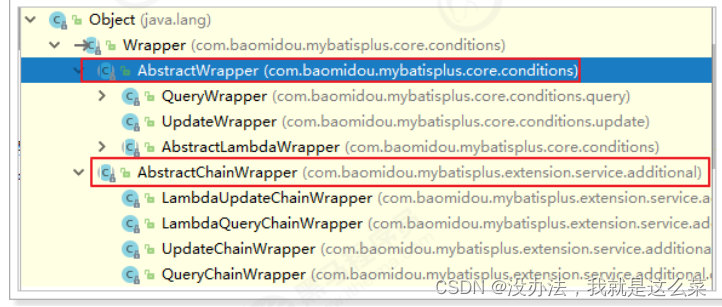
AbstractWrapper和AbstractChainWrapper是重点实现的。
说明:
QueryWrapper(LambdaQueryWrapper) 和 UpdateWrapper(LambdaUpdateWrapper)的父类用于生成sql的where条件,entity属性也用于生成sql的where条件。注意:entity生成的where条件与使用各个api生成的where条件没有任何关联行为
allEq
说明
allEq(Map<R, V> params)
allEq(Map<R, V> params, boolean null2IsNull)
allEq(boolean condition, Map<R, V> params, boolean null2IsNull)
- 全部eq(或个别isNuLL)
个别参数说明:
params:key为数据库字段名,value为字段值,nullisnuull:为true则在map的value为null时调用isNull方法,为false时则忽略value为null的字段
- 例1:allEq({id:1, name:“老王”, age:null}) —>id = 1 and name = ‘老王’ and age is null
- 例2:allEq({id:1, name:“老王”, age:null}, false) —>id = 1 and name = ‘老王’
allEq(BiPredicate<R, V> filter, Map<R, V> params)
allEq(BiPredicate<R, V> filter, Map<R, V> params, boolean null2IsNull)
allEq(boolean condition, BiPredicate<R, V> filter, Map<R, V> params, boolean
null2IsNull)
个别参数说明:
filter:过滤参数,是否允许字段传入比对条件中params与null2isNull:同上
- 例1:allEq(k,v)-> k.indexOf(“a”) > 0, {id:1, name:“老王”, age:null}) --> name = ‘老王’ and age is null
- 例2:allEq(k,v) -> k.indexOf(“a”) > 0, {id:1, name:“老王”, age:null}, false) --> name = ‘老王’
测试用例:
@RunWith(SpringRunner.class)
@SpringBootTest
public class UserMapperTest {
@Autowired
private UserMapper userMapper;
@Test
public void testWrapper() {
QueryWrapper<User> wrapper = new QueryWrapper<>();
//设置条件
Map<String,Object> params = new HashMap<>();
params.put("name", "曹操");
params.put("age", "20");
params.put("password", null);
// wrapper.allEq(params); // SELECT * FROM tb_user WHERE password IS NULL AND name = ? AND age = ?
// wrapper.allEq(params,false); // SELECT * FROM tb_user WHERE name = ? AND age = ?
// wrapper.allEq((k, v) -> (k.equals("name") || k.equals("age")),params); // SELECT * FROM tb_user WHERE name = ? AND age = ?
List<User> users = this.userMapper.selectList(wrapper);
for (User user : users) {
System.out.println(user);
}
}
}
基本操作
- eq
- 等于=
- ne
- 不等于<>
- ge
- 大于等于>=
- lt
- 小于<
- le
- 小于等于<=
- between
- BETWEEN 值1 AND 值2
- notBetween
- NOT BETWEEN 值1 AND 值2
- in
- 字段 IN (value.get(0), value.get(1),…)
- notIn
- 字段 NOT IN (v0, v1, …)
测试用例:
@Test
public void testEq() {
QueryWrapper<User> wrapper = new QueryWrapper<>();
wrapper.eq("password", "123456")
.ge("age", 20)
.in("name", "李四", "王五", "马六");
List<User> users = userMapper.selectList(wrapper);
for (User user : users) {
System.out.println(user);
}
}
效果:

模糊查询
- like
- like ‘%值%’
- 例: like(“name”, “王”) —> name like ‘%王%’
- notlike
- NOT LIKE ‘%值%’
- likeLeft
- LIKE ‘%值%’
- 例: likeLeft(“name”, “王”) --> name like ‘%王’
- likeRight
- LIKE ‘值%’
- 例: likeRight(“name”, “王”) --> name like ‘王%’
测试
@Test
public void testLike() {
QueryWrapper<User> wrapper = new QueryWrapper<>();
wrapper.like("name", "王");
List<User> users = userMapper.selectList(wrapper);
for (User user : users) {
System.out.println(user);
}
}
效果:

排序
- orderBy
- 排序: ORDER BY 字段…
- 例:orderBy(true, true, “id”, “name”) --> order by id ASC, name ASC
- orderByAsc
- 排序: ORDER BY 字段,… ASC
- 例:orderByAsx(“id”, “name”) —> order by id ASC, name ASC
- orderByDesc
- 排序:ORDER BY 字段,… DESC
- 例:orderByDesc(“id”, “name”) --> order by id DESC, name DESC
测试用例:
@Test
public void testOrder () {
QueryWrapper<User> wrapper = new QueryWrapper<>();
wrapper.orderByDesc("age");
List<User> users = userMapper.selectList(wrapper);
for (User user : users) {
System.out.println(user);
}
}
效果:
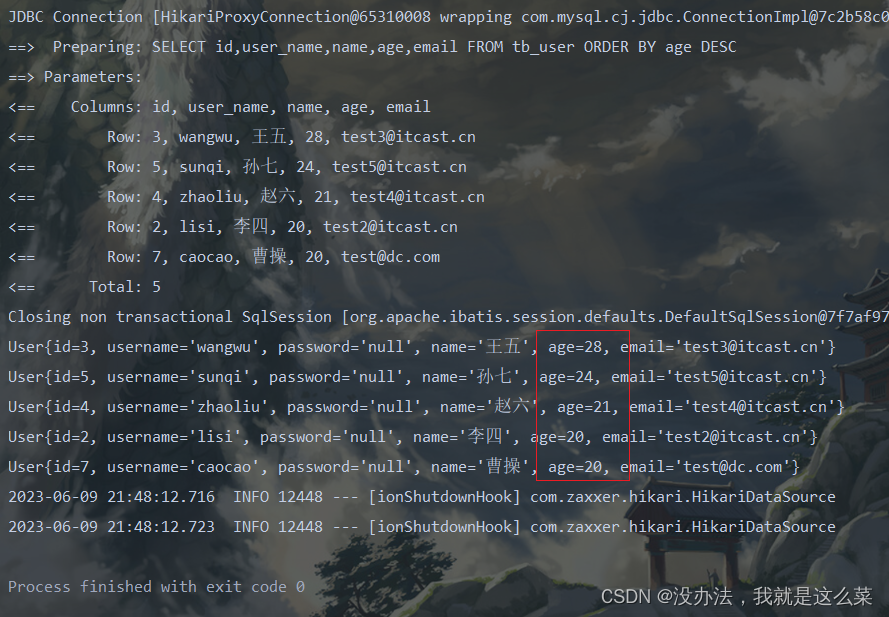
逻辑查询
- or
- 拼接or
- 主动调用or表示紧接着下一个方法不是用and连接(不调用or, 则默认使用and连接)
- and
- ANd嵌套
- 例:and(i -> i.eq(“name”, “李白”).ne(“status”, “活着”)) --> and (name = ‘李白’ and status <> ‘活着’)
测试用例:
@Test
public void testOr () {
QueryWrapper<User> wrapper = new QueryWrapper<>();
wrapper.eq("name", "李四").or().eq("age", 24);
List<User> users = userMapper.selectList(wrapper);
for (User user : users) {
System.out.println(user);
}
}
效果:

select
在MP查询中,默认查询所有的字段,如果有需要也可以通过select方法进行指定字段
@Test
public void testSelect() {
QueryWrapper<User> wrapper = new QueryWrapper<>();
wrapper.select("id", "name", "age");
List<User> users = userMapper.selectList(wrapper);
for (User user : users) {
System.out.println(user);
}
}
效果:




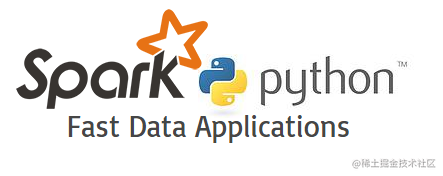
![P2[1-2]STM32简介(stm32简介+ARM介绍+片上外设+命名规则+系统结构+引脚定义+启动配置+最小系统电路+实物图介绍)](https://img-blog.csdnimg.cn/83b9ac2eb8a342b59391756331150525.png)




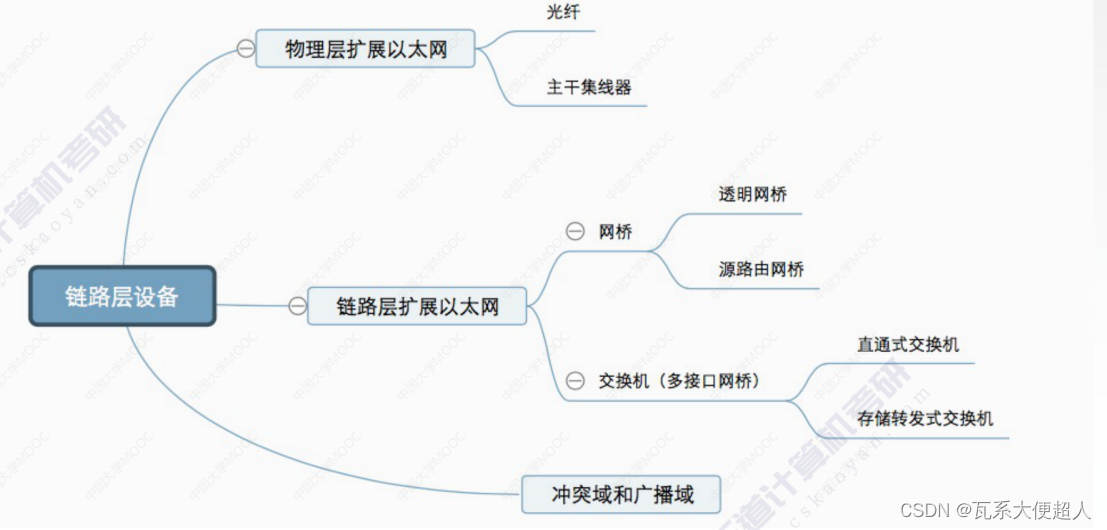


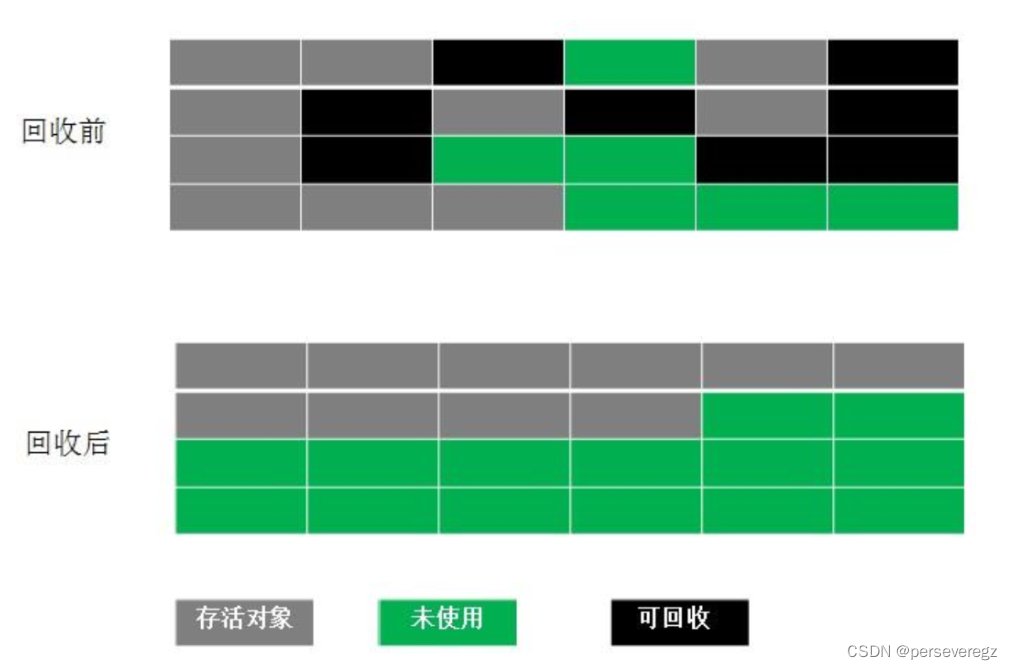

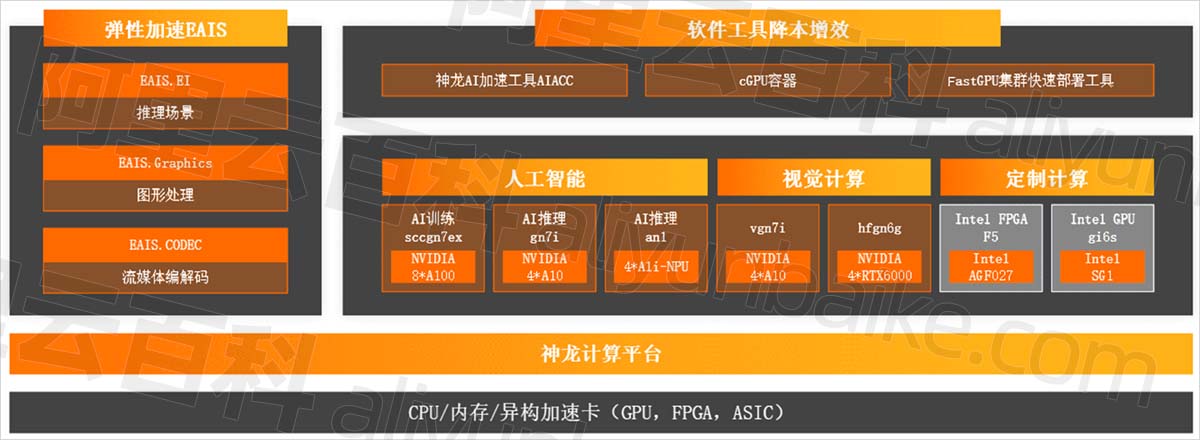
![[Daimayuan] 模拟输出受限制的双端队列(C++,模拟)](https://img-blog.csdnimg.cn/img_convert/c579fddf4fe58f965959dc262fc69109.png)




